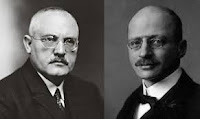Chemistry, well-known as the central science, a creative tributary of science involves the study of the composition, structure, and properties of matter. There are numerous inventions till this date in chemistry and this exercise will not end until the last day of the earth! Actually, Chemistry is the vital part of every living creatures. What they eat to what they wear is the boon of chemistry. Yet, it turns out that most people just don’t have a good idea of what chemists do, or how chemistry contributes to the modern world. Few people know that the discovery of ammonia was the single most important reason for the world’s population explosion from 1.6 billion in 1900 to 7 billion today! Or that polythene, the world’s most common plastic, was accidentally invented twice!
Here, I will reveal, in chronological order, the most significant discoveries made so far that changed the lifestyle of human beings.
1. The Haber-Bosch Process of Synthesis of Ammonia
 |
| Fritz Haber and Carl Bosch Picture from Google |
Nitrogen the most common gas in our atmosphere and plays a critical role in the biochemistry of every living thing. But plants and animals can’t extract it from the air as this gas doesn’t like reacting with very much. Consequently, a major limiting factor in agriculture has been the availability of nitrogen. In 1910, German chemists Fritz Haber and Carl Bosch changed all this when they combined atmospheric nitrogen and hydrogen into ammonia. This, in turn, can be used as crop fertilizer, eventually filtering up the food chain to us. Today about 80% of the nitrogen in our bodies comes from the Haber-Bosch process, making this single chemical reaction probably the most important factor in the population explosion of the past 100 years.
2. Discovery of Penicillin
Before the discovery of antibiotics, a prick from a thorn or a sore throat could have easily turned fatal. In 1928, Alexander Fleming observed how a mold growing on his Petri dishes suppressed the growth of nearby bacteria. But he failed to extract any usable penicillin. In 1939, Australian pharmacologist Howard Florey and his team of chemists figured out a way of purifying penicillin in usable quantities.
 |
| Alexander Fleming Picture from Google |
As World War II was raging at this time, scientific equipment was in short supply. There were thousands of wounded military persons and common people seeking a medicine to cure their wounds. Thank God! penicillin saved their life. By seeing the miracle of penicillin, the team cobbled together a totally functional penicillin production plant from bathtubs, milk churns and bookshelves. Not surprisingly the media were extremely excited about this new wonder drug, but Florey and his colleagues were rather shy of publicity. Instead, Fleming took the limelight.
Full-scale production of penicillin took off in 1944 when the chemical engineer Margaret Hutchinson Rousseau took Florey’s Heath Robinson-esque design and converted it into a full-scale production plant.
3. Discovery of Progesterone
In the 1930s, physicians had realized the potential use of hormone-based therapies to treat cancers, menstrual disorders and of course, for contraception. But research and treatments were held back by massively time-consuming and inefficient methods for synthesizing hormones.
 |
| Progesterone |
Back then progesterone cost the equivalent (in today’s prices) of $1,000 per gram while now the same amount can be bought for just a few dollars. Russel Marker, a professor of organic chemistry at Pennsylvania State University, slashed the costs of producing progesterone by discovering a simple shortcut in the synthetic pathway. He went scavenging for plants with progesterone-like molecules and stumbled upon a Mexican yam. From this root vegetable, he isolated a compound that took one simple step to convert into progesterone for the first contraceptive pill.
4. Discovery of Polyethylene - the common plastic
Polyethylene or polythene is the most common plastic. The annual global production is around 80 million tonnes. Its primary use is in packaging. Most common plastic objects, from water pipes to food packaging and hardhats, are forms of polythene. The 80 million tones of the stuff that is made each year is the result of two accidental discoveries.
 |
| Hans von Pechmann Picture from Google |
Then in 1933, an entirely different method for making the plastic was discovered by chemists at, the now defunct chemical company, ICI. They were working on high-pressure reactions and noticed the same waxy substance as von Pechmann. At first, they failed to reproduce the effect until they noticed that in the original reaction oxygen had leaked into the system. Two years later ICI had turned this serendipitous discovery into a practical method for producing the common plastic that’s almost certainly within easy reach of you now.
5. The Discovery of Liquid Crystal - the screen you are reading on
 |
| Liquid crystal |
Plans for a flat-screen color display date back to late 1960 when the British Ministry of Defense decided that it wanted flat-screens to replace bulky and expensive cathode ray tubes in its military vehicles. It settled on an idea based on liquid crystals. It was already known that liquid crystal displays (LCDs) were possible, the problem was that they only really worked at high temperatures. So not much good unless you are sitting in an oven.
 |
| Phone Screen uses liquid crystal |
Reference:
1. The Conversation Edition, June 1, 2015
2. Google.com., January 18, 2018

No comments:
Post a Comment